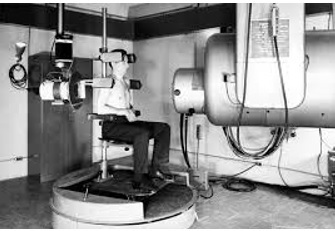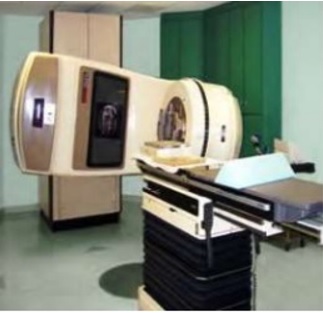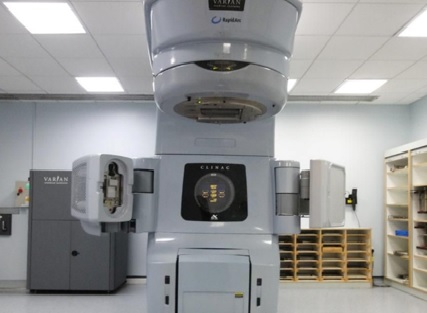linear accelerator
Home > Radiation Protection and Quality Assurance > Equipment Use and Quality Assurance > Linear Accelerator
Can we please get your advice on this one question?
A linear accelerator (LINAC) is a device that uses high Radio-Frequency electromagnetic waves to accelerate charged particles in a linear path or straight lines, inside a tube like structure called the accelerator waveguide. It is commonly used to treat cancer with external beam radiation.
Parts of a Linear Accelerator
1. Drive Stand. It is a large rectangular cabinet that is firmly secured on the treatment room floor.
It consists of:
- Magnetron: Magnetron is a high-power oscillator that generates microwaves through interactions of electrons with magnetic field. The microwave power helps in accelerating the electrons.
- Accelerator waveguide: An accelerator waveguide is a linear structure that conveys electromagnetic waves between its endpoints. It is mounted horizontally in a gantry for high energy single or dual energy machines with klystrons, and vertically for low energy machines with magnetrons.
- Circulator: It is a device that prevents microwaves from being reflected back from the accelerator. It connects magnetron and waveguide.
- Cooling water system: It provides a thermal stability to the system.
2. Gantry. It directs the photons or electrons to the targeted area (patient’s tumor). It can rotate up to 360 degrees around the isocentre.
It is made up of the following components:
- Electron gun. An electron gun is a device that produces a narrow stream of electrons with precise kinetic energy from a heated cathode.
- Accelerator structure. Also called accelerator waveguide.
- Treatment head. It consists of components that are designed to shape and monitor the treatment beams.
3. Collimators. A collimator is a device that focuses or narrows a beam of rays or radiation to be aligned in a different direction or reduce its cross section.
4. Multi Leaf Collimators (MLCs). A MLC is a device made up of individual leaves of high atomic number material, mostly tungsten. They can independently move in and out of a particle beam to conform to the shape of a patient’s tumor.
5. Treatment couch. This is a table where a patient lays still to receive the treatment. It can move right, left, up, down, in and out.
Evolution of Linear Accelerators
First Generation Linacs
The first Linac was used in 1956 at Stanford University in United States. It used to generate 8MV X-ray beam with limited gantry rotation, since they were large and bulky.

First generation Linac
Second Generation Linacs
The second generation linacs were designed between 1962 and 1982. They were isocentric, meaning the gantry could rotate up to 360 degrees from a common focus point. They were better in accuracy and precision than the first generation linacs.

Second generation Linac
Third Generation Linacs
These are the current modern linacs. They have improved in accuracy, precision, dose rates, operating modes, field sizes and operating modes. They are highly reliable and computer driven.

Third generation Linac
How a Linear Accelerator works:
A LINAC uses microwave technology to accelerate electrons in a waveguide, allowing them to collide with a heavy metal target. High energy X-rays (photons) are produced as a result of the collision. The high energy X-rays are shaped as they exit the linac to conform to the shape of the patient’s tumor and the customized beam is directed to the tumor. The beam is shaped by a multileaf collimator (MLC) that is incorporated inside the machine. Radiation can be delivered to the tumor from any angle by rotating the gantry and moving the treatment couch. It has some built-in safety measures to ensure it will not deliver higher doses than prescribed.
Before treatment is delivered, a treatment plan is developed by medical physicist and dosimetrist and approved by the radiation oncologist. Quality assurance procedures are also performed to ensure the treatments are delivered as prescribed in the treatment plan and consistency of the medical prescription. Example of radiotherapy prescriptions:
Importance of Quality Assurance
- It reduces likelihood of accidents and errors during treatment because they will be recognized and rectified during quality assurance procedures.
- It provides reliable inter-comparison of results of treatments.
- It provides an opportunity for full exploitation of improved technology and more complex treatments in modern radiotherapy.
- It reduces uncertainties and errors in equipment performance, treatment planning and treatment delivery.
- Major linear accelerators manufacturers are Varian, Elekta and Siemens.
References
1. Radiology Info. 2018. Linear Accelerators. Retrieved from www.radiologyinfo.org on 2018/12/20.
2. Wikipedia. 2018. Linear Accelerators.
3. Victor M. Tello, MS, DABR. Medical Linear Accelerators and how they work.
Home > Radiation Protection and Quality Assurance > Equipment Use and Quality Assurance > Linear Accelerator
FREE Infographic What successful people believe. What successful people do
Dictionary of Cancer Terms
Need help understanding a word? Here is an electronic resource that gives meaning to Cancer terms and their usage.

StrengthsFinder 2.0